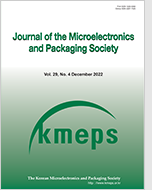
Search
- Past Issues
- e-Submission
-

KCI Accredited Journals KCI 등재지
KCI Impact Factor 0.54
Editorial Office
- +82-2-538-0962
- +82-2-538-0963
- kmeps@kmeps.or.kr
- http://kmeps.or.kr/

KCI Accredited Journals KCI 등재지
KCI Impact Factor 0.54
Journal of the Microelectronics and Packaging Society 2024;31(3):38-41. Published online: Oct, 30, 2024
DOI : doi.org/10.6117/kmeps.2024.31.3.038
In semiconductor manufacturing, the alignment process is fundamental to all manufacturing steps, and alignment errors are inevitably introduced. These alignment errors can lead to issues such as increased resistance, signal delay, and degradation. This study systematically analyzes the changes in the electrical characteristics of the bonding interface when alignment errors occur in metal interconnect and bonding structures. The results show that current density tends to concentrate at the edges of the bonding interface, with the middle part of the interface being particularly vulnerable. As alignment errors increase, the current path redistributes, causing previously concentrated current areas to disappear and an effect similar to an increase in contact area, resulting in a decrease in resistance in certain vulnerable parts. These findings suggest that proposing structural improvements to eliminate the vulnerable parts of the bonding interface could lead to interconnect with significantly improved resistance performance compared to existing structure. This study clarifies the impact of alignment errors on electrical characteristics, which is expected to play a crucial role in optimizing the electrical performance of semiconductor devices and enhancing the efficiency of the manufacturing process.
Keywords Bonding, Current density, Bonding interface, Contact resistance, Misalignment, Metal interconnects